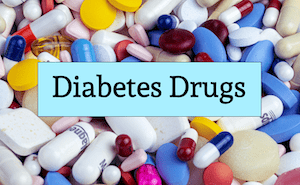Diabetes Drugs
 Below please find an overview of the most commonly used drugs for type 1 diabetes and type 2 diabetes. Click each drug to learn more information, including a list of the currently approved drugs in each class and the benefits and drawbacks of each type.
Below please find an overview of the most commonly used drugs for type 1 diabetes and type 2 diabetes. Click each drug to learn more information, including a list of the currently approved drugs in each class and the benefits and drawbacks of each type.
Metformin – Metformin decreases glucose production from the liver, thus lowering blood sugar.
Insulin – The main job of insulin is to facilitate glucose uptake into the body’s cells. Insulin is a hormone made by the pancreas. Most insulin is taken by injection or through a pump, though inhaled insulin is also available.
SGLT-2 inhibitors – SGLT-2 inhibitor drugs block the process of reabsorbing glucose back into our blood, causing glucose to be excreted through urine.
Incretins – incretin-based therapies, sometimes called incretin mimetics, work by copying (“mimicking”) the actions of natural incretin hormones, which help lower blood sugar after eating.
GLP-1 receptor agonists – GLP-1 RAs are a type of incretin-based therapy. GLP-1 is a hormone produced in the small intestine. It stimulates insulin secretion and inhibits glucagon secretion to lower blood sugar.
DPP-4 inhibitors – Inhibiting the enzyme DPP-4 increases the level of hormone GLP-1 to stimulate insulin production and decrease glucose levels.
Combination drugs – Combination therapies put multiple drug classes into a single medication. Combinations can be injectable or taken as a pill.
Sulfonylureas – Sulfonylureas stimulate the beta cells in the pancreas to release insulin.
TZDs – TZDs bind to a particular protein in cells to activate genes and create new proteins that reduce insulin resistance and help glucose enter cells.
Glucagon – Glucagon is a hormone made by alpha cells in the pancreas that increases blood glucose. Ready-to-use glucagon is used to treat severe hypoglycemia, or dangerously low blood sugar.
*Please note that this page is not a comprehensive list of all available diabetes drugs.
